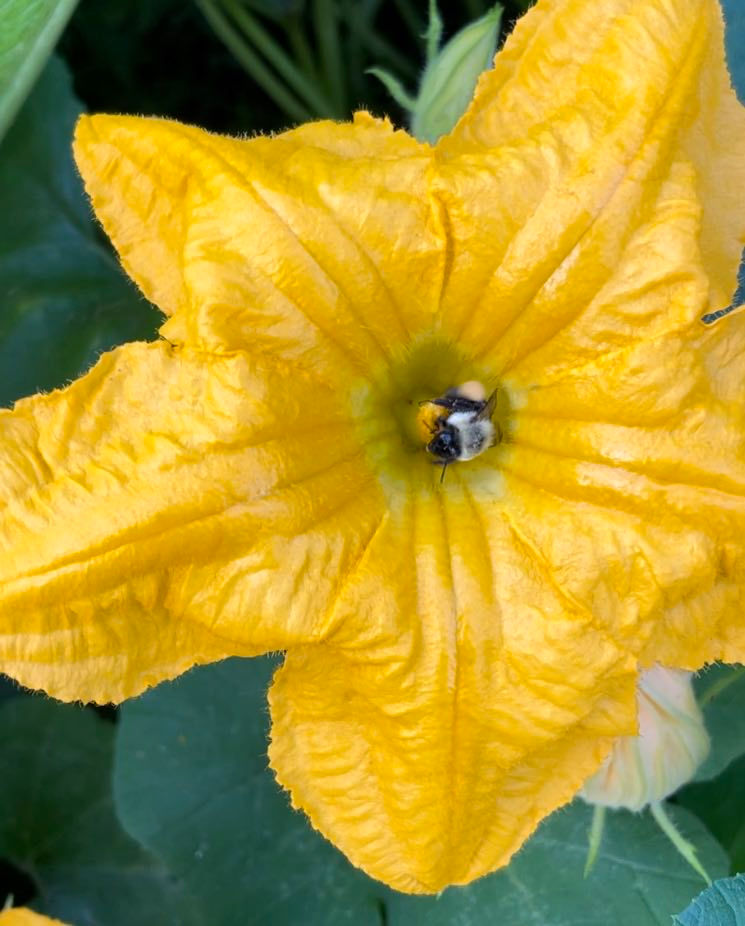The Vital Dance of Bees: A Fascinating Look at Pollination
- Michele Pulis

- Aug 24, 2023
- 3 min read

A bee in one of our pumpkin blooms...
Introduction
In the intricate tapestry of nature, few creatures play a role as essential as that of the humble bee. With their diligent buzzing and tireless efforts, bees serve as nature's most proficient pollinators. The phenomenon of pollination is a remarkable dance that sustains ecosystems and ensures the reproduction of countless plant species. In this blog post, we will delve into the world of bees and their vital role in the process of pollination.
The Ballet of Pollination
Imagine a world without colorful flowers, succulent fruits, or flourishing vegetables. That would be the bleak reality if not for pollination – the transfer of pollen from the male part of a flower to the female part, which is necessary for plant reproduction. Bees, along with other pollinators like butterflies, birds, and bats, are the stars of this natural ballet.
The Pollination Process
When a bee visits a flower in search of nectar, it inadvertently brushes against the flower's male reproductive organs, collecting pollen on its body. As the bee continues its quest for nectar, it lands on another flower, transferring some of the collected pollen to the stigma, the female reproductive organ. This transfer enables fertilization and the production of seeds, which ultimately leads to the growth of new plants.
Bee Anatomy and Adaptations
Bees are uniquely adapted for their role as pollinators. Their bodies are covered in tiny hairs that help them trap and carry pollen efficiently. The hairs on their legs form specialized structures called pollen baskets, where they store collected pollen for transportation back to the hive. Additionally, bees have a keen sense of color and can see ultraviolet light, allowing them to identify and navigate flowers with precision.
The Mutual Benefit
The relationship between bees and plants is a textbook example of mutualism, where both parties benefit. Bees receive nutrient-rich nectar from flowers, which they use to produce honey and feed their colonies. In return, the flowers get the gift of pollination, ensuring the continuation of their species. This interdependence underscores the delicate balance of ecosystems.
Biodiversity and Ecosystem Health
The decline of bee populations has raised concerns about the health of ecosystems. Factors such as habitat loss, pesticide use, climate change, and disease have contributed to the decline of bee populations worldwide. As a result, the pollination of many crops that humans rely on is at risk. This situation emphasizes the need for conservation efforts and sustainable practices to protect these essential pollinators.
Human Impact and Solutions
Recognizing the vital role bees play in food production, several initiatives have emerged to safeguard bee populations. Planting bee-friendly gardens, reducing pesticide use, and creating habitats that support pollinators are just a few steps that individuals and communities can take. Governments and organizations also play a pivotal role in promoting policies that protect bee habitats and regulate pesticide use.
Conclusion
Bees and pollination are a testament to the intricate web of life on Earth. The partnership between these buzzing insects and flowering plants sustains ecosystems and provides us with a diverse range of foods. Understanding the significance of pollination encourages us to cherish and protect these vital creatures. As we continue to learn about the delicate balance of nature, let us remember the invaluable contribution of bees – the unsung heroes of the pollination dance.



Comments